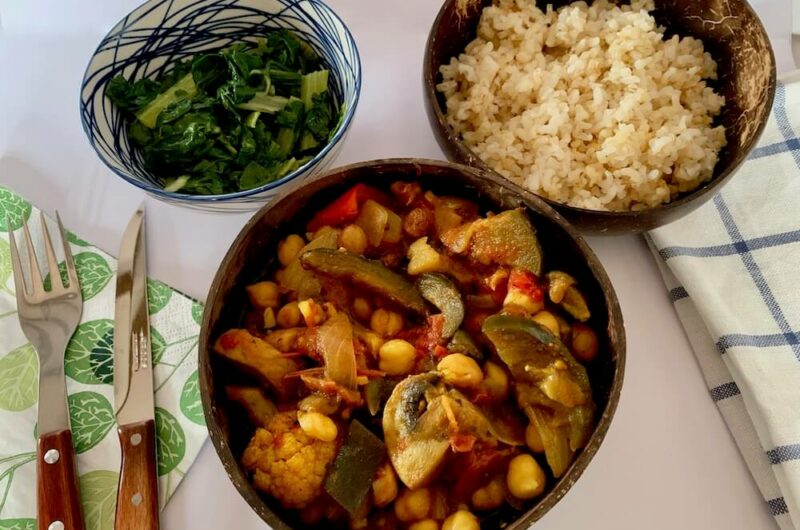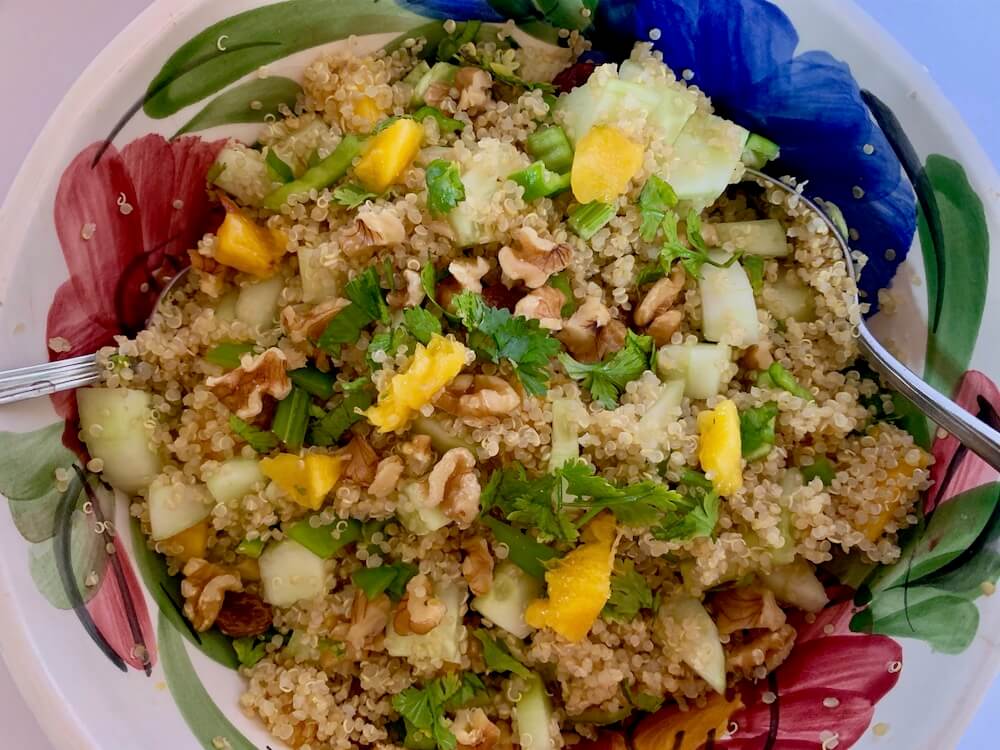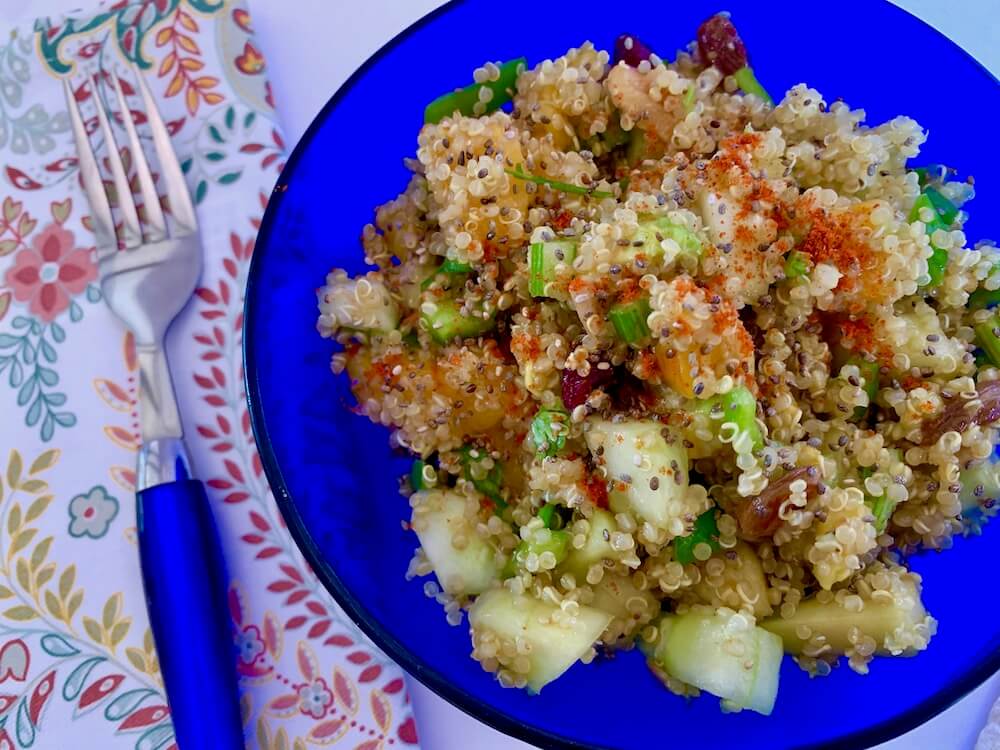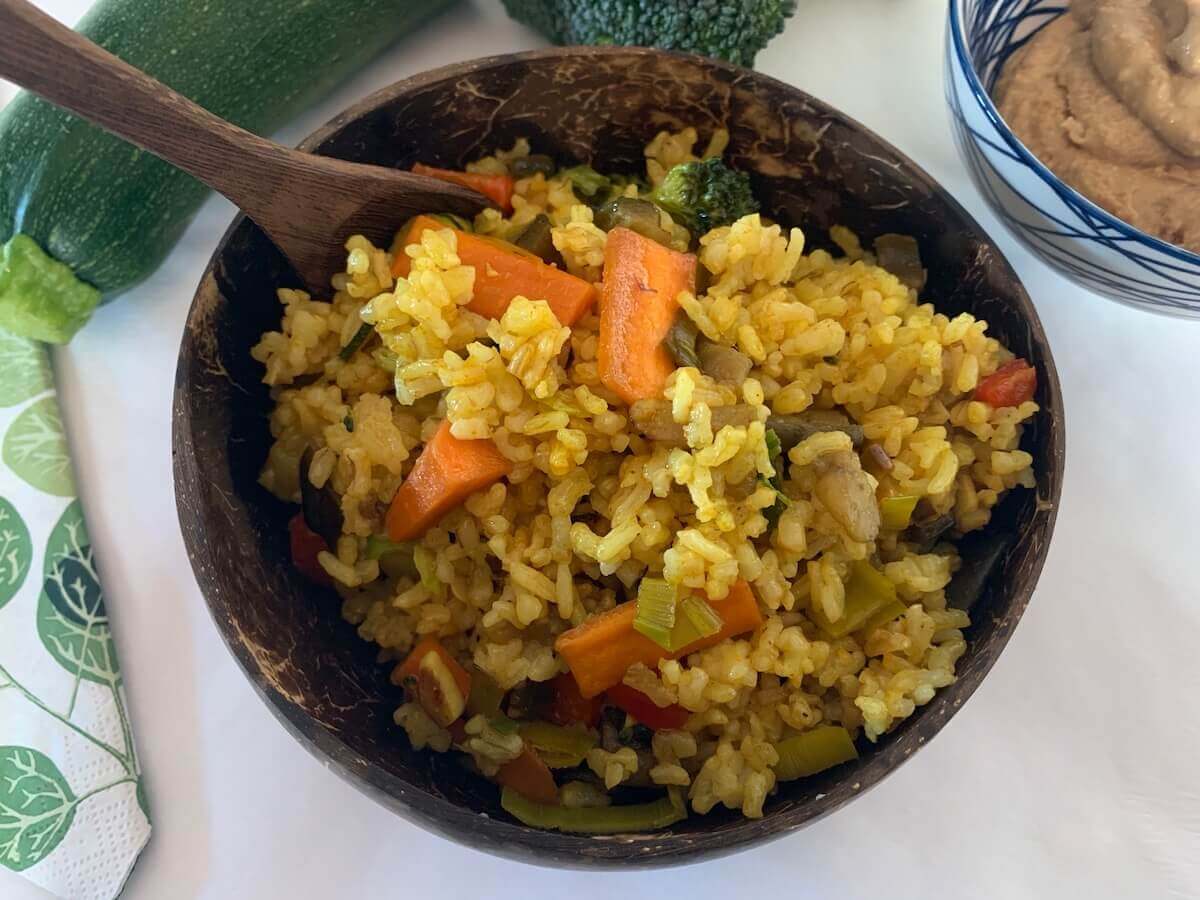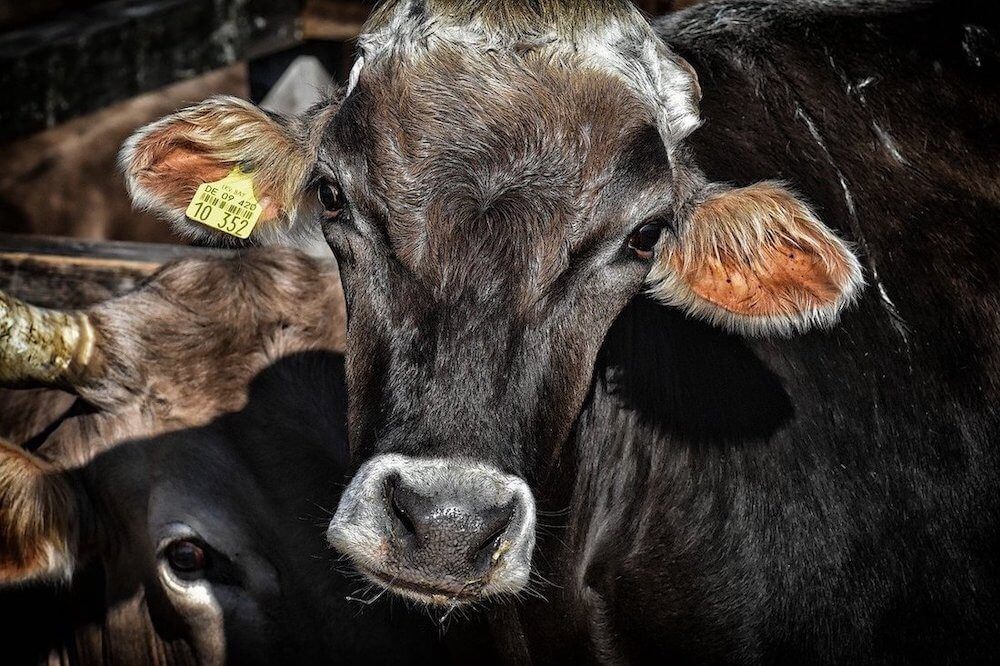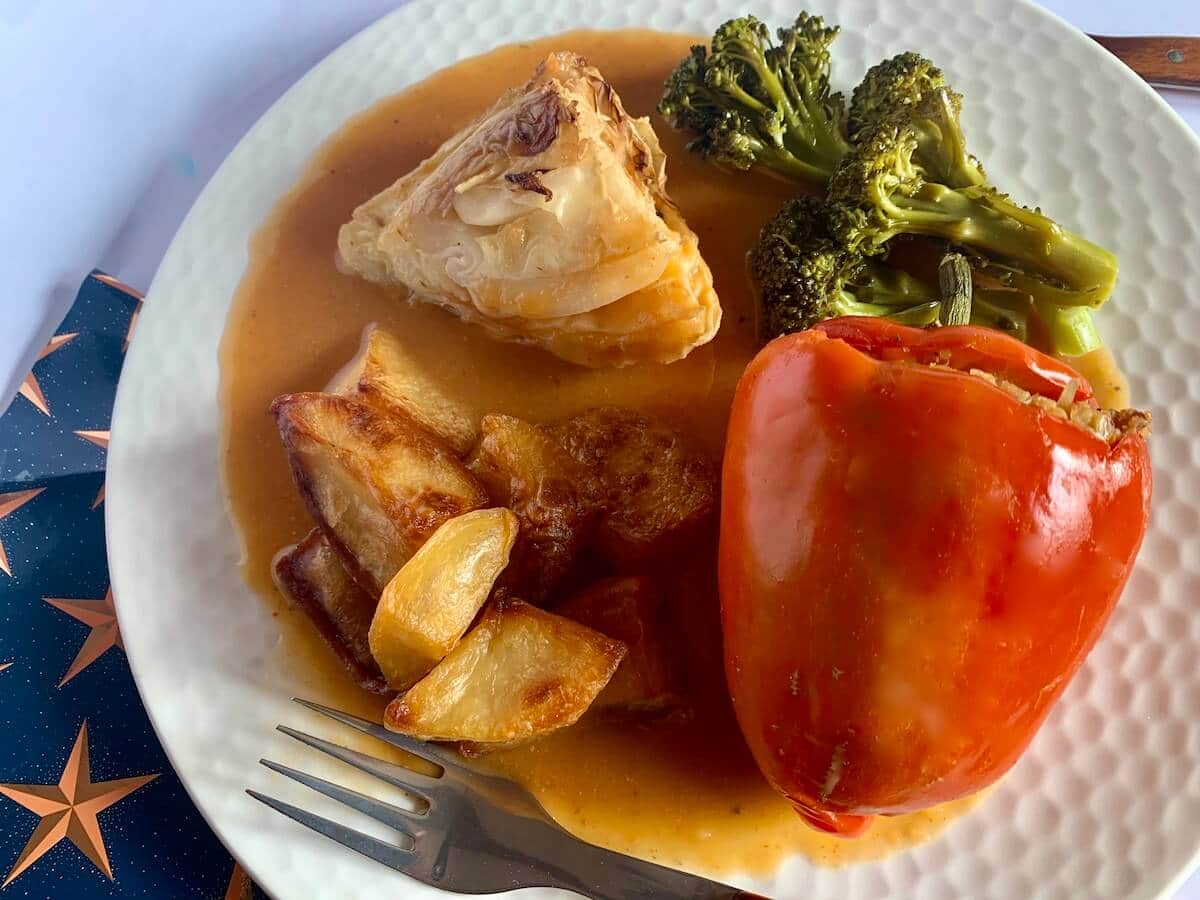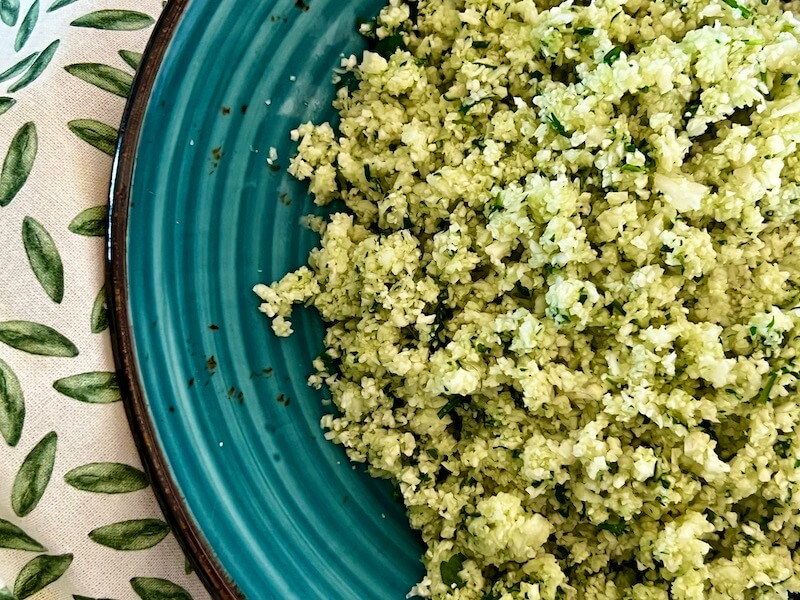This vegan eggplant curry with chickpeas is a great way to use up leftover veggies you have in the fridge, or whatever vegetables you have to hand.
You can basically use whatever veggies you have left over to complement the eggplant.
Serve this curry with rice, quinoa or part of a complete thali spread and some spinach or fresh Swiss chard.
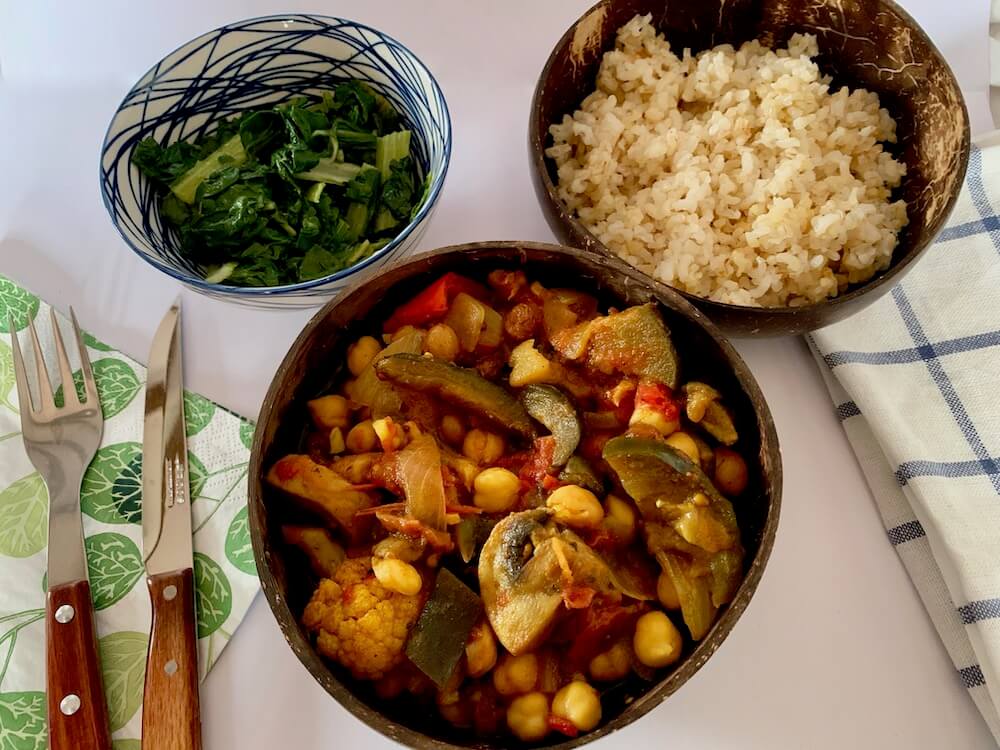
When I was a young child, my best friend was of Indian descent and I used to spend a lot of time with the family.
I have such fond memories of those times and of her mum, cooking the spices in the kitchen.
We used to eat a potato shack and homemade chapatis and puris galore. The food back then was made less spicy for us kids, but now I love to eat food with a kick to it.
You can make this vegan eggplant curry as spicy or as mild as you like.
It works well both ways.
Table of Contents
Flexi Method for Making a Vegan Curry with Chickpeas
When you make a curry, it’s a creative process. Once you have your favourite curry dishes, you can whip them up without seeking out the recipe.
Of course, I like to find new recipes for new flavours, but some old favourites like this one can be whipped up in no time by following a flexible process.
This means making use of the ingredients you have handy.
What you should decide when you start out, is whether to make a dry curry (potatoes in turmeric for example) a juicy curry like this eggplant curry, or a creamy curry, like this vegan coconut curry recipe.
Today we’re making a tomato-based vegan eggplant curry, so without further ado, let’s get on with it.
Tomato-Based Eggplant Curry
On this occasion, I had an eggplant which wasn’t young and tender. The skin would be getting a bit tough at this stage.
Plus, it probably wouldn’t have the best flavour anymore so I wouldn’t use it for stuffed eggplant or eggplant parmesan, both of which call for fresher, younger eggplants in my opinion.
I rummaged through the fridge and pulled out the veggies I had: a piece of red pepper and a chunk of cauliflower.
So, to that I added 1 onion, 2 tomatoes and 4 mushrooms, and the base for my curry was set. And the motto? Use what you have to hand to go in with your vegan eggplant curry recipe!
You can make this eggplant curry with cauliflower, broccoli, spinach, mushrooms, chickpeas etc. The choice is yours. The essential parts of the curry are eggplant, onion, chickpeas, garlic, spices & tomato.
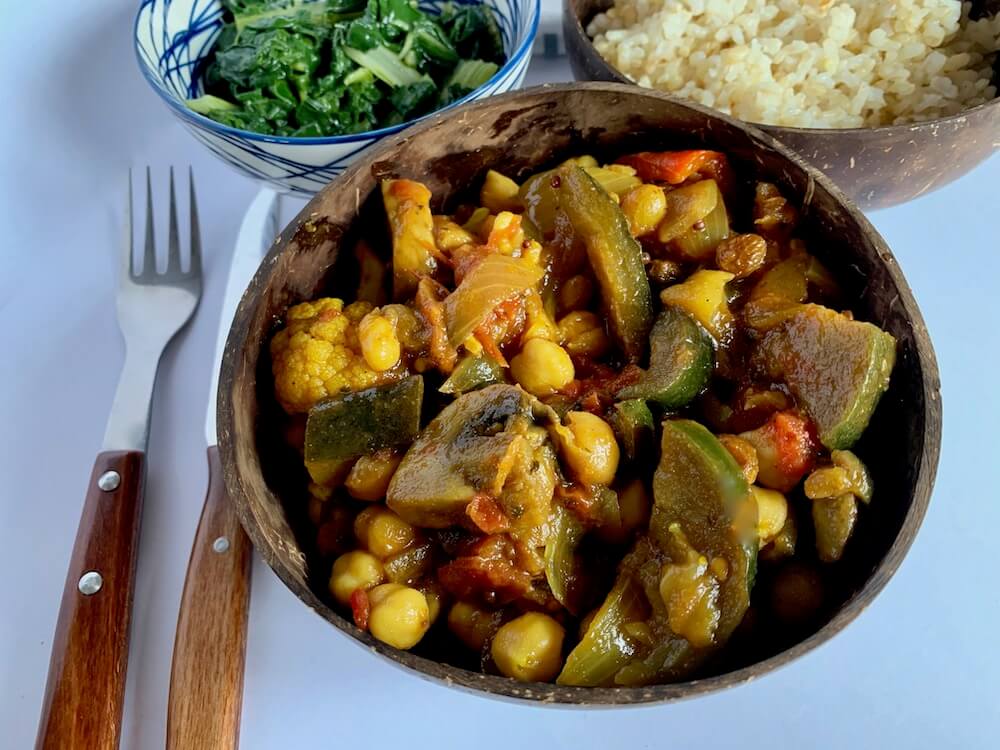
How to Make the Eggplant Curry
Sweating the Eggplant
When cooking with eggplant, you have the option to sweat it. This means covering the cubes in salt and using your hands to make sure all the eggplant is covered, rubbing the salt in.
Leave to stand in a bowl for about 20-30 minutes and you’ll see a brown liquid collecting in the bottom of the bowl.
At this point, you want to run the eggplant slices under cold water, making sure that you rub each piece individually to remove the excess salt.
Be aware that the salt gets right into the flesh so a simple rinse isn’t enough, you need to actually rub the eggplant.
Do a taste test to check the salt level in the eggplant after rinsing and rubbing under the running water.
The benefits of sweating an eggplant are that any bitterness is drawn out into the liquid, the flesh becomes tenderised and the remaining salt brings out the natural flavour of the vegetable perfectly (as long as you make sure to get rid of the excess salt).
Also, after being treated in this way, the eggplant won’t absorb all the oil as it might when fried from raw. It is a magical transformation!
Having said all that, if you have a tender young eggplant, you can also skip this stage.
Preparing the Other Vegetables for the Eggplant Curry
Heat a little olive oil in a frying pan or pan of your choice and wait for it to be hot before adding some black mustard seeds.
When the seeds begin to pop, reduce the heat and add some finely chopped ginger, garlic and chilli.
Next, add the spices: cumin, paprika, coriander, turmeric and if you like – a curry blend of your choice.
On this occasion I used a Jalfredo curry blend but I often just add individual spices.
After a moment, put half a sliced onion into the pan and stir.
As soon as the onion is coated in spices, add the cauliflower or other hard veg and cook in the spices for a few minutes before adding the red pepper and mushrooms (or soft vegetables such as spinach etc).
You have the choice between using tinned tomatoes, which you will add later on, or fresh tomatoes. If using fresh, add them at this stage, once the mushrooms are softening and veggies semi cooked.
After allowing the mix to cook for a few minutes, add some water or vegetable stock, just enough to cover the base of the pan with about a centimetre of liquid. Leave the vegetables to cook in the liquid while you get back to the star of the recipe . . .
Back to the Eggplant
Meanwhile, rinse the eggplant well and squeeze out the excess water.
After doing the taste check to be sure you’ve got rid of the excess salt, pat it dry with some kitchen paper.
In a separate pan, heat a little olive oil and add the half onion, chopped eggplant and some garam masala.
Fry for a few minutes and then add the 4 chopped mushrooms and leave to cook for around about 7 minutes or until the eggplant is cooked. Taste it to check.
Next, add the curry base to the eggplant.
Unless you are making a separate chickpea curry, I would add these as they offer a great source of plant protein and they go perfectly.

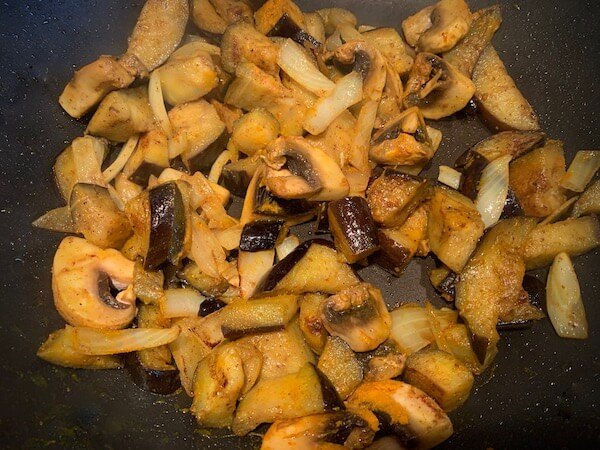


The Final Stages of Making an Eggplant Curry
Pour the curry base into the eggplant pan and stir.
Add some cooked chickpeas (home cooked or a jar/tin will do fine) and a tin of tomatoes, and heat through. If you used fresh tomatoes, adjust the tinned tomatoes accordingly.
Switch off the heat and cover with a lid.
At this point, taste the curry before you decide what to add next.
If you like the curry to be sweeter, you can add sultanas, raisins or dried cranberries or blueberries. I added a handful of sultanas, and I left it to infuse.
The curry flavour improves with time, so if you can, make it a few hours before you want to serve.
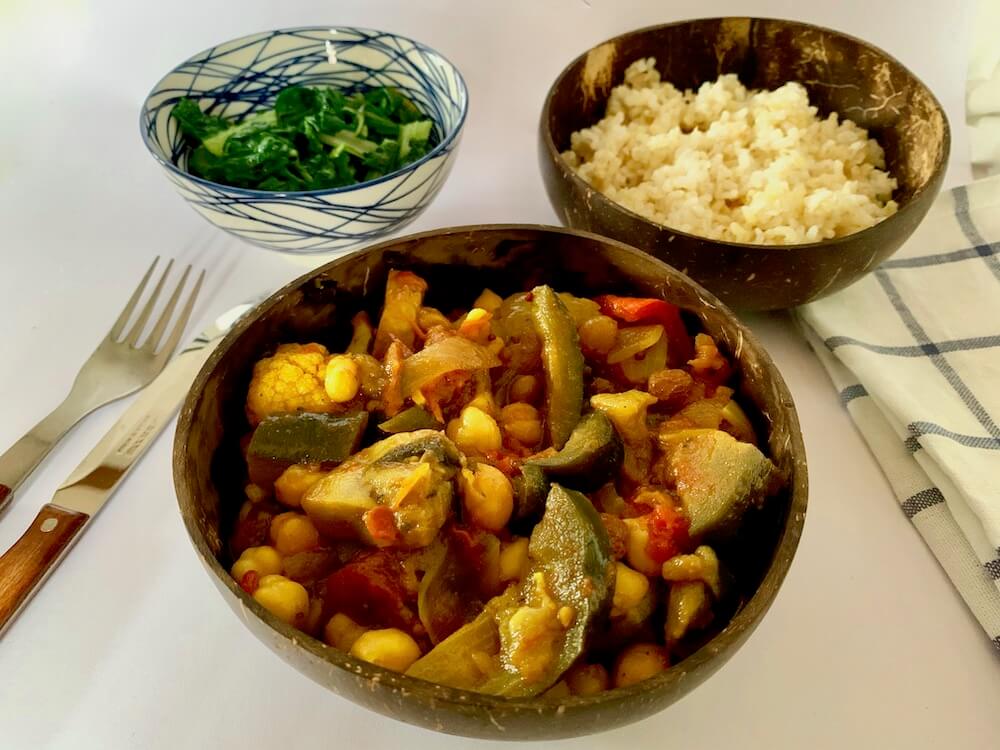
Later, reheat the curry and add a little extra water to create more juice if necessary.
Served the final meal with wholegrain rice, a green vegetable and a gluten-free wrap on the side. And extra chilli on the side of course!
Vegan Eggplant Curry with Chickpeas
Course: Main courseCuisine: Indian InspiredDifficulty: Average4
servings30
minutes30
minutesChange the ingredients to whatever you have in your cupboard and fridge!
Ingredients
1 eggplant
1 onion
4 mushrooms
1 piece cauliflower
1 piece red pepper
4 large tomatoes (or use tinned)
2 cloves garlic
Piece of fresh ginger the size of a garlic clove
fresh chilli
curry spices: cumin, turmeric, paprika, coriander, garam masala or a spice blend
Vegetable stock or water
salt & pepper
Directions
- Put the eggplant to sweat in a coating of salt while you prepare the base for the curry.
- Fry the fresh ginger, garlic and chilli in a little olive oil.
- Add half the chopped onion and spices of choice and cook for a few minutes.
- Add the rest of the veggies you’re using and stir fry for a few minutes.
- If using fresh tomato, put these into the pan now and fry to cook with the veggies.
- Pour on the vegetable stock until the veggies are just covered and cook on low-medium heat for 10 minutes.
- Set aside until the eggplant is ready.
- For the eggplant
- Heat a little olive oil in a pan and add the garam masala, chopped eggplant and onions, cut into strips lengthwise.
- After a moment, add the chopped mushrooms and stir.
- Leave to cook for about 7 minutes or until the eggplant is cooked through.
- Putting it all together
- Mix the eggplant with the curry base.
- Pour in one jar or tin of chickpeas.
- Heat through before adding a tin of chopped tomatoes.
- Taste the curry and add a handful of sultanas.
- Adjust the seasoning to taste.
- If you can make the curry in advance it will taste much better. Cover with a lid and leave to cool. Reheat when ready to serve.
Notes
- The secret of the tastiest cooking, including a good curry, is to be flexible and vary it according to what you have to hand.
